Are you curious about the Norwegian coastal voyage? Join me as I take the full 11-night roundtrip experience in the winter on the brand new coastal cruise ferry, Havila Polaris.
Regular readers will know I’m a huge fan of Norway’s coastal ferry service, currently operated by seven Hurtigruten ships and four brand new Havila vessels. As I live in Trondheim, I use the service every so often to travel down to Molde or Ålesund.
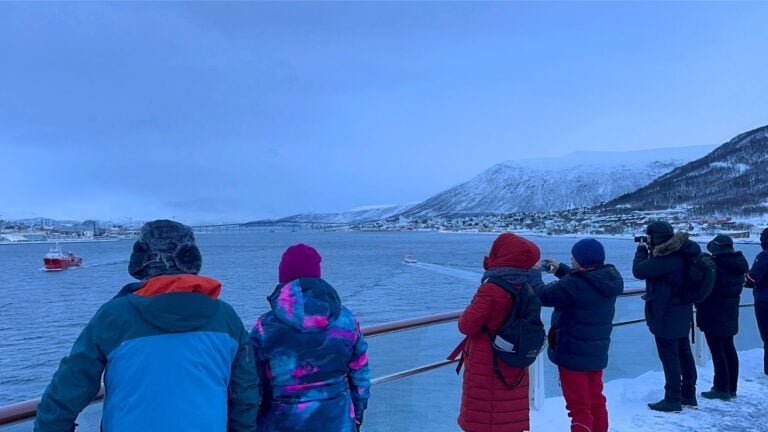
Outside Norway, the service is best-known for its cruise experiences that are bolted on to the ships’ primary function as a ferry. The most famous is the full 11 night Bergen-Kirkenes-Bergen roundtrip.
Having taken the Havila Capella from Ålesund to Trondheim recently, I instantly became a fan of the line. So much so, that I immediately looked into doing the full roundtrip with Havila.
Daily Diary of the Northbound Leg: Bergen to Kirkenes
I’ve only taken the full trip once before, back in 2019 on Hurtigruten’s Vesterålen just before it was renovated. I published a daily diary of my journey here on Life in Norway.
Are you a fan of Norway? Follow the rest of this journey and my future ones on the Life in Norway Instagram
Not only did it prove popular with readers, it’s also been great to look back on over the years. So, I’m doing it again! This time I’m going to publish it in just two parts: northbound and southbound. I hope you enjoy.
Day 0: Arrival in Bergen
It would have been much easier for me to board and disembark in my home city, taking a Trondheim-Kirkenes-Trondheim route. But with my journalist hat on, I knew that wouldn’t satisfy me or my readers!
I get so many questions about the full coastal voyage, that I decided to travel down to Bergen and embark there. As is recommended by many, I travelled down the day before.
Although I could easily have flown from Trondheim to Bergen in time to embark the ship on the same day, I didn’t want to take any chances. All travel in the Norwegian winter carries with it a certain risk of cancellations, so I took no chances.
My day was mostly taken up by travelling, but also checking the weather forecasts for the week to come. The Facebook group ‘Hurtigruten Insiders’ was full of updates from travellers currently docked in Tromsø, as a winter storm has forced the ferry to stay put.
I also saw online that two of the other Havila ships had been affected by the storms too. But thankfully, my ship, Havila Polaris, was heading towards Bergen on time.
I stayed overnight in my preferred Bergen accommodation, Radisson Blu Royal at Bryggen. This would give me a chance to spend some time wandering around the city the following morning.
Day 1: Embarkation in Bergen
After a good sleep and a good breakfast, I took the funicular up to Mount Fløyen. It's kind of become a habit of mine when in Bergen. The fresh air and spectacular views always seem to help me start the day off in the right way!
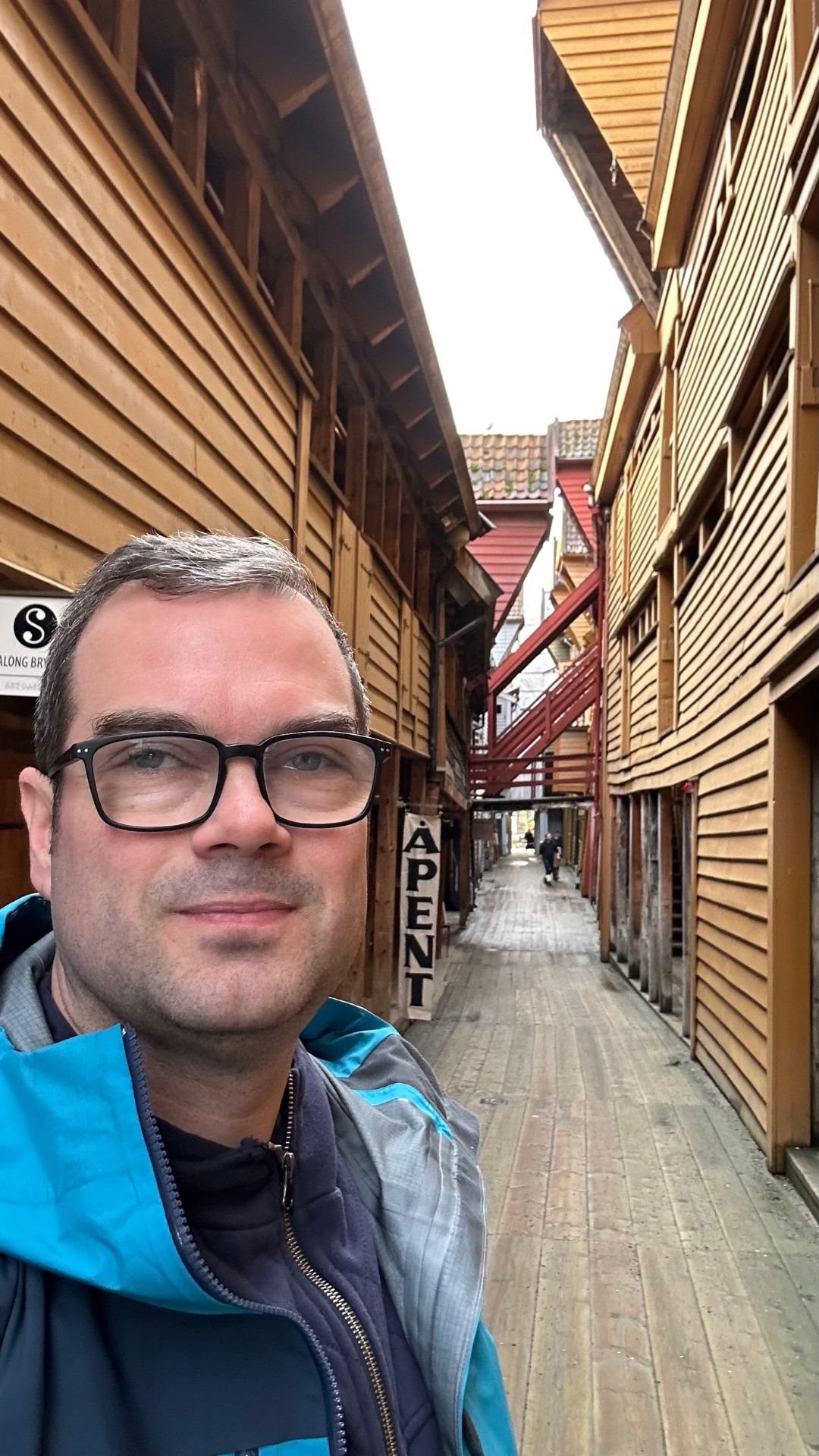
I followed that up with a quick visit to Bryggen, as my hotel was right by there.
After a few hours working and thanks to a late check-out arranged in advance with the hotel, it was soon time to head over to the terminal.
Check-in began at 4pm and I arrived a little early. Or at least, I thought I had! It turned out check-in opened as early as 3pm, and there was already a sizeable queue. It took me about 40 minutes before I was checked-in and rid of my luggage.
That was a little longer than I would have liked, but the plus point was that the ship was ready for boarding as soon as I’d completed this process. So it just shuffled around the waiting period, really!
There was another bit of a wait to sort out dining arrangements, but as the cabins weren’t yet ready, that wasn’t such a problem.
Having already spent some time on a different ship in the fleet, I knew what to expect on the Havila Polaris, so immediately went to grab a latte (included in the meal package) and sit in my favourite part of the ferries, the Bow Lounge.
Just after 6pm, the cabins were ready. I was thrilled with mine! It’s right at the front of the ship, which will probably mean I’ll feel the movement more, but it’s spacious with tons of storage space.
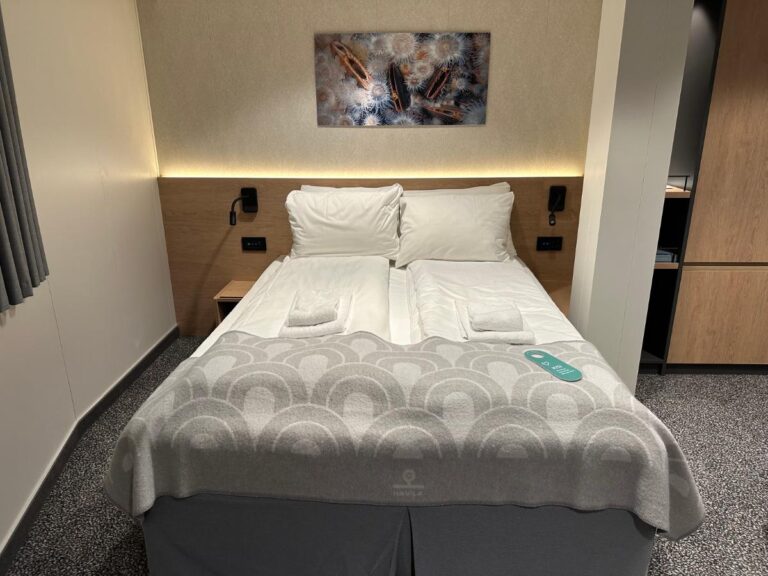
After unpacking, I attended a short introduction talk and then made my way to dinner, which was open seating on the first night. Service was a little chaotic, but the food was absolutely sensational. I had sashimi of fjord trout, slow-cooked lamb, and panna cotta. Five stars!
I made it out on deck just in time to watch some of the sailway from Bergen. There’s so much outside space on Havila Polaris, so people were spread around the ship taking in the views.
The first few hours on board were thoroughly enjoyable. My only concern now is the first night’s sailing around the infamous Stad peninsula. The weather seems to have calmed down now. Only time will tell!
Day 2: A Day in Ålesund
It was indeed a rough night, albeit not as much as I'd feared. Some rollercoaster-like movement kept me awake for a while, but in the end I slept well, just not for long enough.
There was a noise keeping me awake for some time. It turned out to be two spray cans that I hadn't secured properly, rolling into each other inside the wardrobe. But it took me an hour to realise that! Lesson learned.
I awoke to the news on the Havila website that we would be missing a bunch of ports on day 3 due to the weather. Although not surprising, it's disappointing, as I had planned to meet some friends in Trondheim to show them the ship.
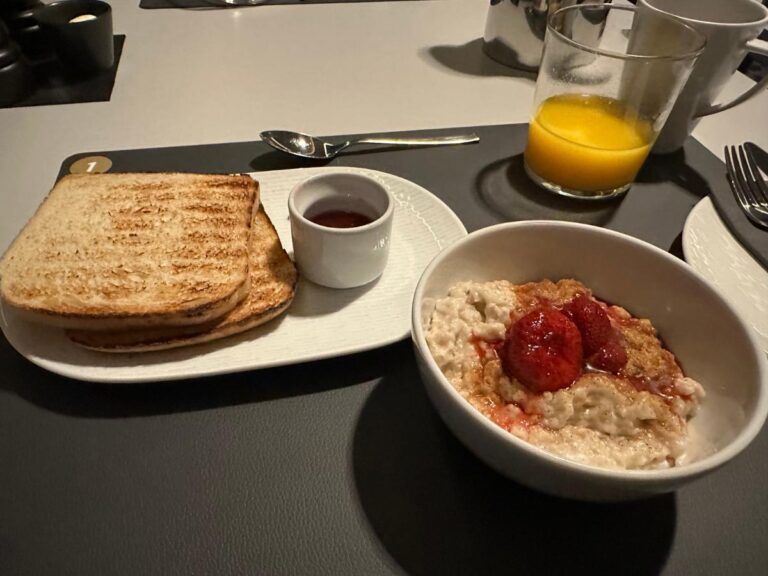
The news hasn't been announced yet, and I'm sure there'll be plenty of disappointment on board. I know many people were looking forward to visiting Trondheim, in particular. Still, this is the realities of sailing in the Norwegian winter. Safety always comes first!
I have an early time for breakfast so I don't intend on having it every morning, but this morning I did as I wanted to check out the concept. As with lunch, it's an a la carte menu of small dishes, and you can order as much or as little as you like.
We made an early morning stop in Torvik, very close to the home of Havila. The sail-in was the first opportunity for everyone to appreciate the beautiful scenery of the Norwegian coastline, and the first of many tiny communities we'd visit.
It was just the briefest of calls to collect cargo and drop-off local passengers, but that didn't bother anyone as we would soon be making the longest stop of the entire voyage.
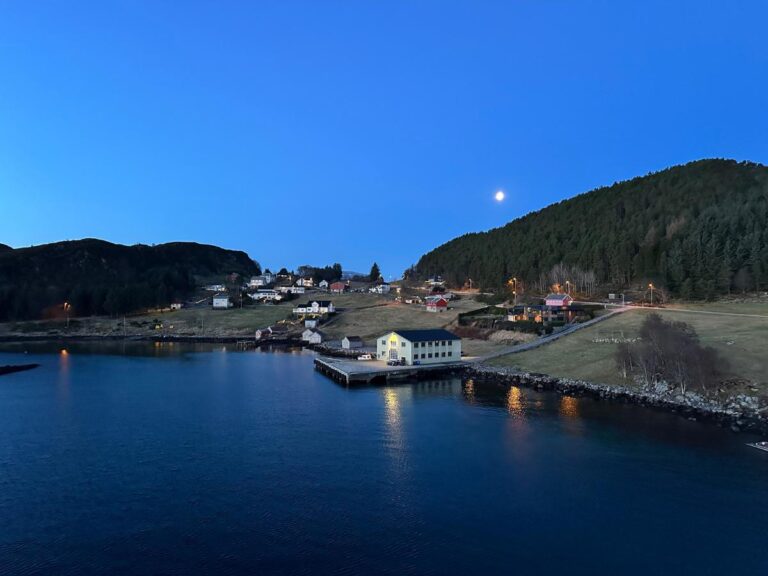
One of the quirks of sailing in the off-season is the ten-hour stop in Ålesund, easily the longest stop of the route.
That's because in June, July, and August, the ferry visits the Geirangerfjord before returning to Ålesund. In September and October, it visits the Hjørundfjord. But in the winter season, it stays in Ålesund throughout that time.
Thankfully for me, I'm a big fan of Ålesund! Although I did stay on the ship to record my ship tour video (coming soon!) and get some other work done, I did make time to catch up with my friend Elise.
A great thing about this trip is because they are local ferries, people can come and go as they please. That also includes locals, who often visit the ships. In some ports where the stay is long enough, they become a form of daily cafe. So, Elise came on board and we chatted over a coffee!
Later in the afternoon I took the chance to go for a quick walk around Ålesund, down to the waterfront and up the famous steps of Mount Aksla.
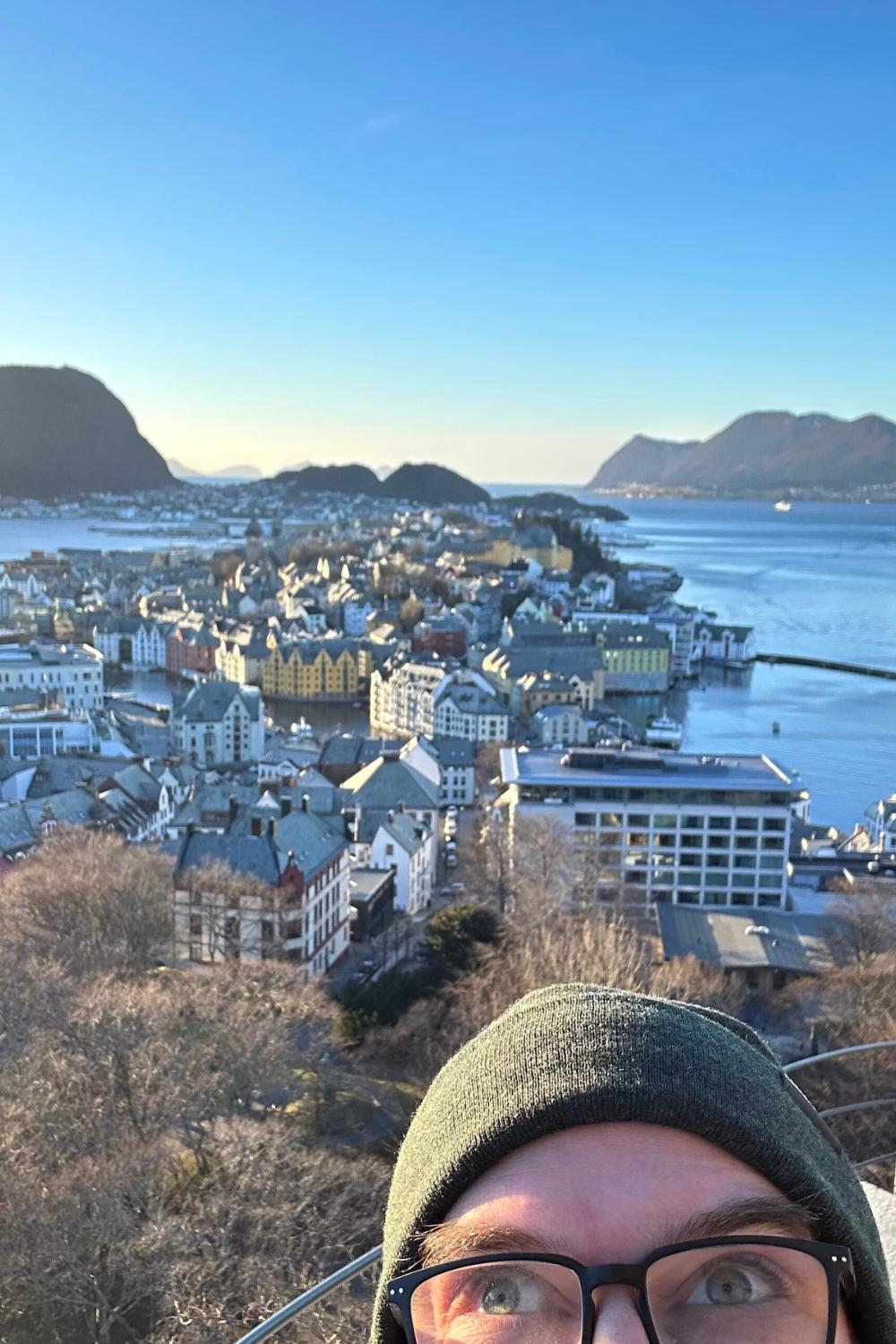
Back on the ship, a meeting was held by the expedition team in which the change in schedule was confirmed. This understandably surprised a lot of people as we hadn't experienced any bad weather yet, although some people had read about the impending storms. Even so, after such a lovely day, it was hard to believe a hurricane was about to hit the west coast!
Day 3: An Unexpected Sea Day
With Trondheim, Rørvik, Brønnøysund, Sandnessjøen, Nesna, and Ørnes all cancelled, we would sail directly to Bodø. But that meant a complete day at sea on day 3, which was totally unexpected at the start of the voyage and a very rare occurrence on the Norwegian coastal route!
So, what to do on a sea day? I took the chance to relax, finish off recording my ship tour, and get to know some of my fellow passengers.
A lot of people following my updates on Instagram assumed we were sailing through rough seas, but that wasn't the case at all. Aside from some bumps as we sailed around Hustadvika–a notorious stretch of open sea–the ship was relatively stable most of the day.
The reason we missed the six ports wasn't so much that the ports themselves were unsafe. It was so we could get to Bodø before Storm Ingunn hit land.
During the evening we crossed the Arctic Circle and the crew held a competition to guess the precise time. Later in the evening, we got a visit from Njord, god of the sea, who toasted our arrival with a sour concoction of orange, ginger, and chilli!
I took advantage of the lack of port stops by choosing to visit Hildring, the fine dining restaurant, during the evening.
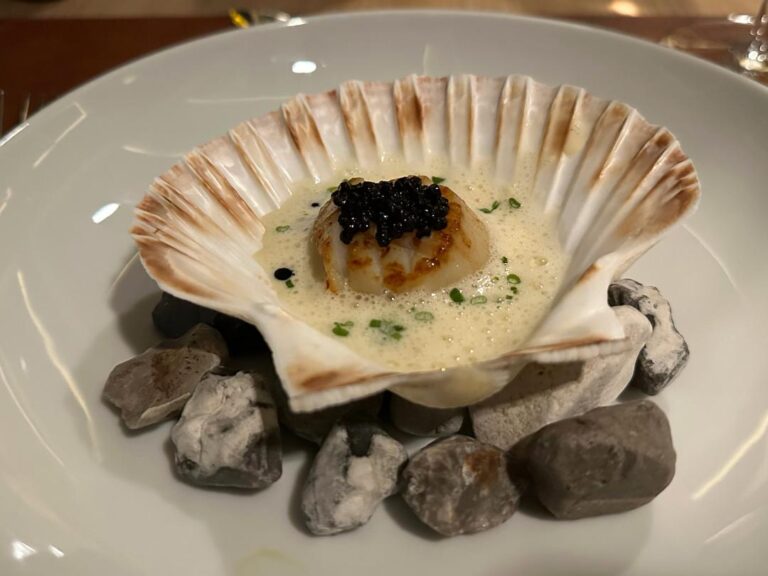
Simply put, the food was outstanding: King crab, scallop, turbot, lamb, and a terrific dessert. Although it costs an additional fee to visit Hildring, it's worth it. But you don't have to visit here to get great food. The dinners in the main restaurant have been to a far higher standard than I'd expected.
Day 4: Storm Ingunn in Bodø
My fourth day started very early as I was awoken by an incredibly loud noise at about 30 minutes after midnight.
After I'd come to my senses, I realised we were dropping anchor at the port in Bodø. With the forecasted storm set to arrive within hours, this was probably a wise move!
By 7am when I emerged for breakfast, it soon became clear we would not be able to leave the ship for any significant length of time during the day. Nevertheless, I took a few minutes “fresh air” to film this quick video:
As you can see, or certainly hear (!) the wind was reaching uncomfortable levels. It made it hard to walk, and dangerous with the potential for things flying about.
Just an hour after I filmed this video, the Police shut down the city centre and issued an alert using the national emergency warning system. This caused quite the surprise on the ship when people's mobile phones started bleeping! Storm Ingunn made quite the impression.
Because of the strong winds, the outside decks were kept closed for most of the day. This meant we essentially had another sea day. Yet, people were in high spirits. Most appreciated the unique circumstances of the storm, helped by the fact it had made international headlines.
The expedition team ran an update session on Tromsø and Honningsvåg, the main ports on the following two days, and even held an impromptu “fashion show” to showcase not just what was available in the shop, but also how Norwegians dress for winter and hiking, etc. This seemed to go down very well with the other guests!
I also took the opportunity to interview Daniela, one of the German crew, for my podcast. Listen out for that episode, coming soon.
Just after 4pm it was finally time to lift anchor and set sail for Lofoten. Stamsund was cancelled so we sailed directly to Svolvær over the bumpy Vestfjorden, but the bumps lasted just two hours before calming down. I managed to enjoy dinner during the crossing, but several others chose to skip it.
At about 9.20pm we pulled into Svolvær. It was chilly and it was snowing, but that didn't stop huge numbers of roundtrip guests leaving the ship to get some fresh air and walk about.
I took two American sisters I met on board into the city centre to show them ‘the sights', but it was only really when we got back on board that we could see what makes Svolvær great.
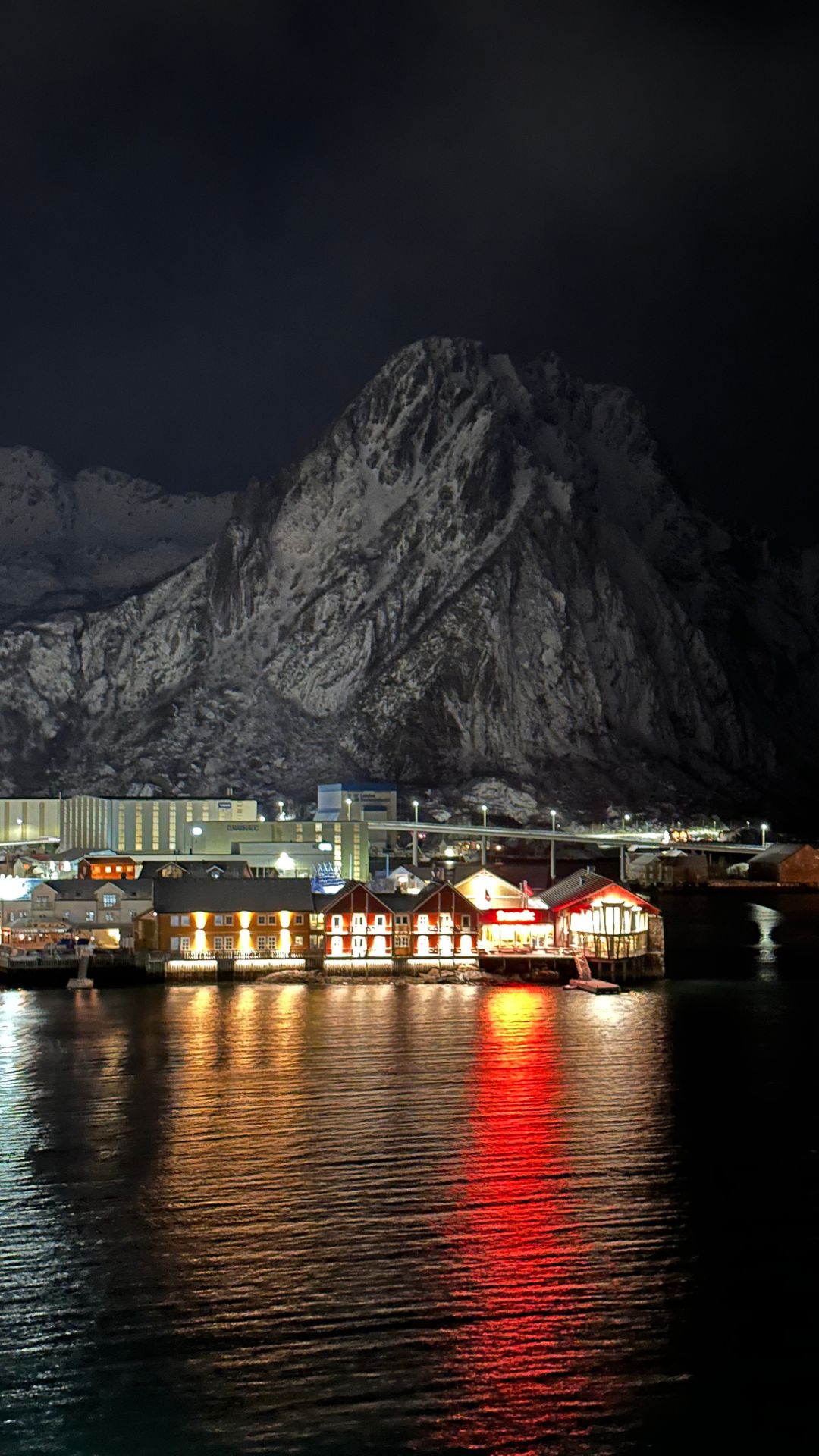
It stopped snowing, the clouds lifted, and the mountains came into view. The timing was perfect, as it coincided with the first outdoor event of the voyage. The team served rømmegrøt (Norwegian sour porridge) with mugs of gløgg.
Day 5: Tromsø
In the morning, it felt as if we had finally returned to normal operations. There were a few local passengers in the cafe, which had quickly become my default spot during the mornings. Among other things, to write this diary!
Local passengers are the bread and butter of Havila and Hurtigruten, and it was only now I realised how quiet it had been during the last two days with the relative lack of local passengers–primarily because of all of the missed ports.
We'd called at Stokmarknes, Sortland, and Risøyhamn overnight, and made an early morning call at Harstad. The scenery had also transformed into something more resembling Arctic, with snow-dusted mountains on both sides of the ship.
In the late morning, we made a short stop at Finnsnes, and I dashed into the town for a quick look around.
After lunch back on the ship, we made our way past Ryøya, an island in the middle of a sound known for its strong tidal currents. Although a beautiful spot, I was one of the few people out on deck taking photos as the wind was strong and bone-chilling.
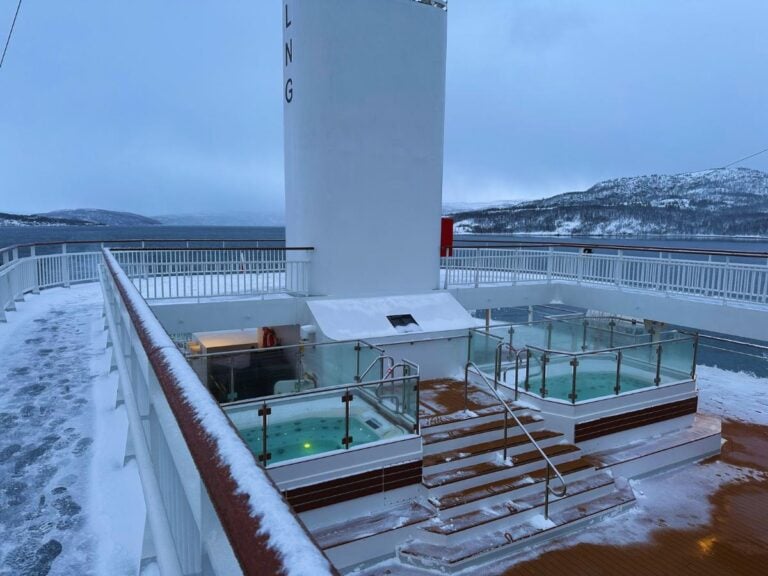
Soon, as we were sailing towards Tromsø, the wind subsided, and the weather improved. Tromsø came into view and looked fantastic in its winter coat. Many people gathered on the outside walkway around the observation lounge to watch the sail-in.
It seemed as if most roundtrip guests had booked excursions, as I was one of the only people to leave the terminal by the regular exit! I’ve been to Tromsø so many times over the years that I decided to just have a wander around.
It was an ideal time to arrive in the city as the blue light gradually deepened over the course of an hour or two. After a quick visit to the Cathedral, I made the spur-of-the-moment decision to visit Magic Ice.
The bar is inside a chilled room and packed with ice sculptures. It’s an expensive tourist trap but one I’ve enjoyed in the past, although I have to say I think the one in Svolvær is a lot better. At least, it was the last time I went two years ago. Still, I enjoyed my visit regardless.
Before getting back on the ship, I took a few more photos and visited a supermarket to stock up on soft drinks and snacks. As much as I enjoy the coastal voyage, both Hurtigruten and Havila are extremely expensive on board, especially for soft drinks.
You can’t take alcohol on board the ships, but you can walk on with a bag of soda, no questions asked!
After another fantastic dinner of trout sashimi and baked cod, I retired to the observation lounge to relax with an Aperol Spritz. It was quiet on board the ship, but there was a notable increase in local passengers today.
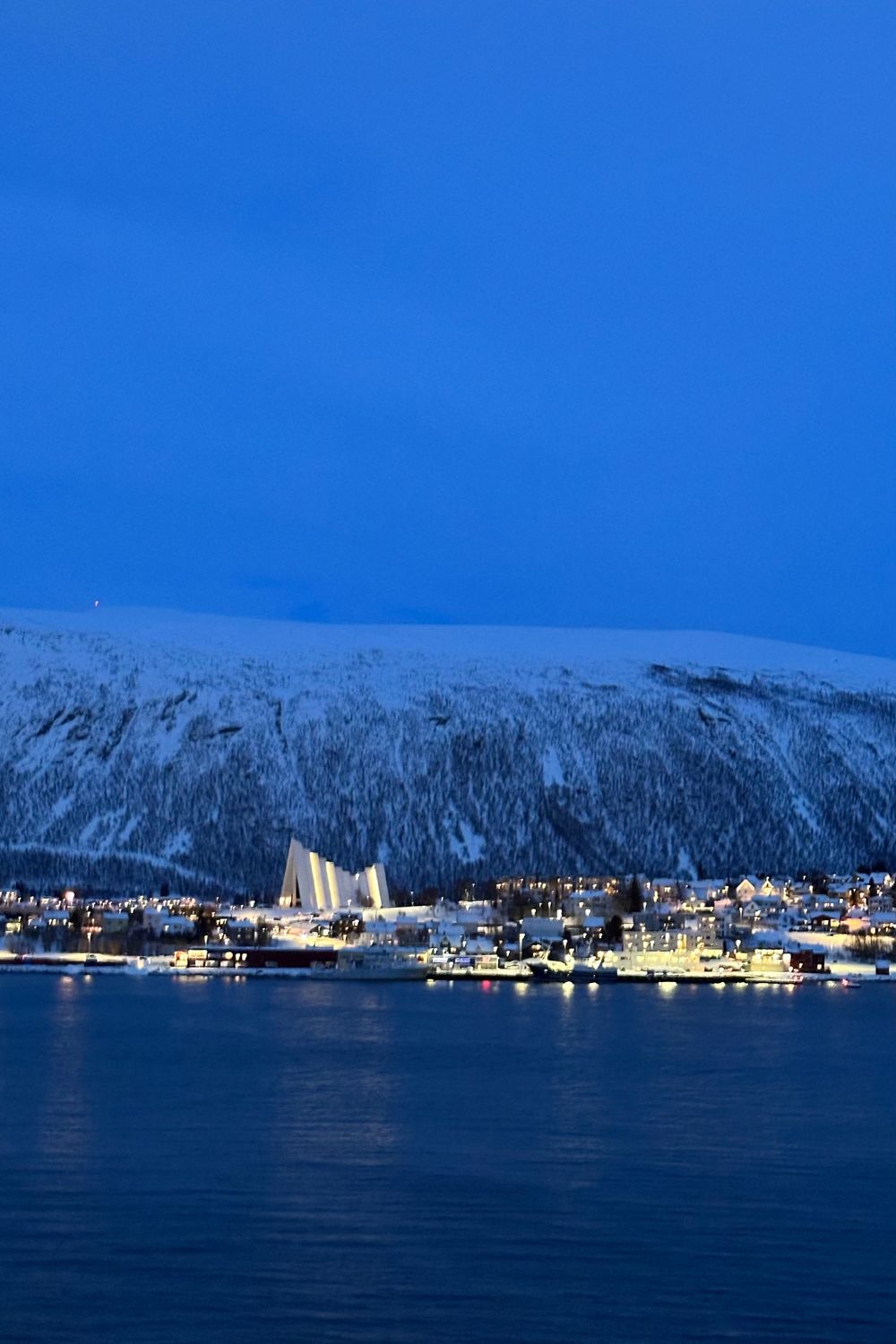
At about 9.15pm we passed the southbound coastal ferry Hurtigruten Nordkapp. An announcement was made and the two ships exchanged greetings with their horns. This is something I’ve always enjoyed on the coastal route as it emphasises both the history and importance of the route.
The fact it was the first crossing I’d seen in the daytime on day five just shows how bad the weather has been and how badly other ships’ itineraries have been impacted by the storms.
Before going to bed, I stayed up to watch the late night sail-in and arrival to Skjervøy. With just a 15 minute stop there was no time to get off the ship, but I always enjoy looking at these small communities from the top of the ship.
Even late at night in the dark, there's so much to see and wonder about. Who lives here? What do they do? And so on!
Day 6: Nordkapp
In the morning, I enjoyed a light breakfast and then headed out on deck for the arrival into Havøysund. This fishing village of less than 1,000 people competes for most picturesque port, especially in the winter with the snow and the deep blue light.
Soon it was time to dock in Honningsvåg and for my first excursion of the trip: a bus tour to Nordkapp (the North Cape). I've been there several times but I wanted to take this trip now to experience the plateau–and the drive there–in the winter.
As it turns out, we were the first tour group to be able to travel to the cape in a week, so we have been super lucky with our timing once again. I'm going to make a video about the day so I'll save most of my thoughts for that, but the overall experience was wonderful.
The drive across a snowy Magerøya island was sensational, and we were fortunate to have a clear day at Nordkapp to appreciate the scenery. The visit is timed almost perfectly to take advantage of the few hours of proper daylight in early February.
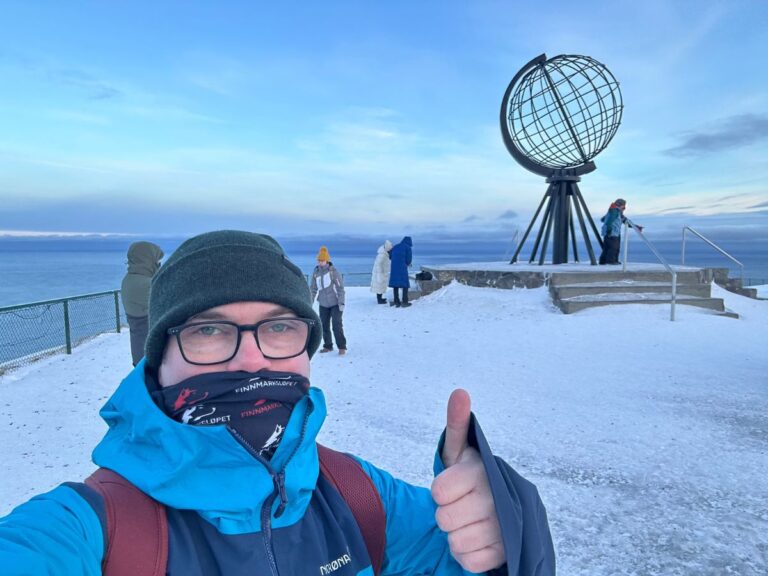
I've said before that Nordkapp is a bit of a tourist trap and while that is true (it has what must be Norway's biggest gift shop!), I also think a visit here at least once is a must.
When I got back to the ship, it was time to meet Sverre, the navigation officer on the Polaris, for a fun YouTube video that will be coming out in as few weeks.
I got to briefly see the bridge, which is always a fascinating place to be on a ship. The basics are the same of course, but everything felt a little newer. The most interesting part were the port-side controls, used to manoeuvre the ship into port.
Some of the entrances to the ports–especially small villages in the north–are tiny, and I've spent a lot of time on this trip watching us manoeuvre into place. It really is a lot more fascinating that it sounds!
In Kjøllefjord I watched a few people disembark the ship to join a snowscooter excursion. They were actually travelling from one port to another by snowscooter in the darkness. Watching them walk off, I found myself wishing I was joining them. Next time!
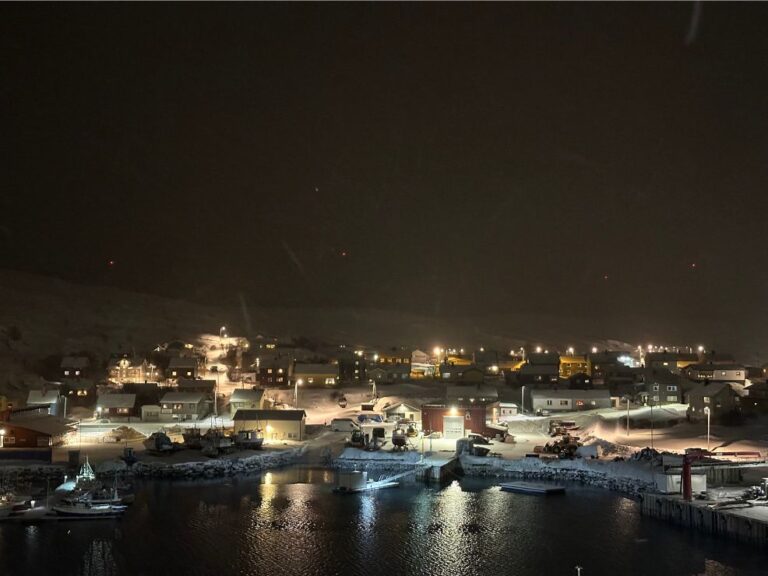
With the northbound voyage coming to an end and a relatively early start in Kirkenes tomorrow (I had an excursion planned), I decided to get an early night.
Or I should say, tried to get an early night! We encountered unexpected rough seas around the exposed coastline of the extreme northeast of Norway.
I say unexpected, but rough seas in this part of the world are not exactly unusual. But they hadn't been forecasted for this night, so it came as a bit of surprise. Although I didn't feel sick or queasy at all, I just couldn't get to sleep because of the movement.
At about 3am, I got up and went for a walk around the empty public decks, and ended up chatting to Stefan on reception. It turned out we had just decided to miss the nighttime call at Vadsø as it was too dangerous to approach the harbour on the tiny island.
I did manage to get a couple hours of sleep in the end, so I wasn't entirely exhausted for turnaround day and my visit to the snow hotel.
Are you a fan of Norway? Follow the rest of this journey and my future ones on the Life in Norway Instagram
The northbound trip has been eventful to say the least, and sadly for guests only taking the one-way voyage, we have not seen the northern lights. However, with better weather forecast for the next few days, the chances seem good for the start of the southbound trip.
Speaking of the southbound trip, you don't have to wait! I've now published part two of my daily diary. So, head on over there to see how this journey ends.

